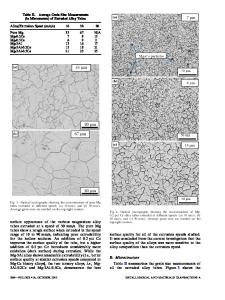Strain-Controlled Low-Cycle Fatigue Properties of a Newly Developed Extruded Magnesium Alloy
- PDF / 2,468,888 Bytes
- 13 Pages / 593.972 x 792 pts Page_size
- 34 Downloads / 286 Views
TION
THE low density of magnesium (1.7 gm/cc vs 2.7 gm/cc for aluminum and 7.8 gm/cc for steel), combined with the high strength-to-weight ratios of magnesium-based alloys have made these alloys more attractive than conventional structural materials: steels and aluminum alloys.[1–4] Rising concerns about global warming that is directly affected by vehicle emissions can be reduced to certain extent if the total mass of each automobile is decreased. A report published by the United States Automotive Materials Partnership (USAMP) expressed the vision of increasing the use of magnesium alloys by 340 lbs per car by the year 2020 (only about ~10 to 12 lbs of magnesium alloys were used in a typical car in 2006), which will lead to a substantial reduction of vehicle mass by about 15 pct. To achieve this goal, it is essential to develop high strength wrought magnesium alloys with good formability as a substitute of some structural parts S. BEGUM, Graduate Student, and D.L. CHEN, Professor and Ryerson Research Chair, are with the Department of Mechanical and Industrial Engineering, Ryerson University, Toronto, ON M5B 2K3, Canada. Contact e-mail: [email protected] S. XU, Research Scientist, is with CANMET–Materials Technology Laboratory, Natural Resources Canada, Ottawa, ON K1A 0G1, Canada. ALAN A. LUO, Technical Fellow, is with the General Motors Research and Development Center, Warren, MI 48090. Manuscript submitted July 8, 2008. Article published online October 10, 2008 3014—VOLUME 39A, DECEMBER 2008
considered. Currently, the majority of the magnesium alloys used in automotive applications are cast alloys because of their high productivity, although wrought magnesium alloys normally provide better properties in terms of strength than the cast magnesium alloys. Limited strain-controlled low-cycle fatigue (LCF) data of these cast alloys and some wrought alloys are available,[5–13] but less formability of the wrought alloys makes it challenging for high-volume production. Recent development of a new wrought magnesium alloy, AM30, by General Motors Research and Development Center (GM R&D)[14] has certainly shown some improved properties. Experimental results showed that AM30 magnesium alloy has better formability than that of AZ31 alloy, leading to a higher productivity in manufacturing automotive components. So far no work has been reported on the LCF behavior of the AM30 alloy, in spite of a limited number of publications available on the fatigue behavior of other magnesium alloys, e.g., AZ31,[6–8] ZK60,[9] AM50,[10] and AZ91.[11] The objective of the present investigation was, therefore, to ascertain the cyclic deformation characteristics (cyclic hardening or softening) of the extruded AM30 magnesium alloy, determine the fatigue life under varying strain amplitudes, and evaluate cyclic parameters, such as, cyclic strain-hardening exponent, cyclic strength coefficient, fatigue strength coefficient, fatigue strength exponent, fatigue ductility coefficient, and fatigue ductility exponent. Moreover, the effect of strain ratio and METAL
Data Loading...











